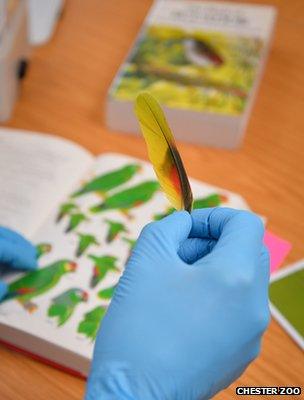Discovery offers Ecuador Amazon parrot 11th hour hope
- Published

In the wild, Ecuador Amazon parrots depend on two habitats - mangroves and dry forests
A South American parrot has been reclassified as a species in its own right, which could help save the bird from becoming extinct in the wild.
Until now, the Ecuador Amazon parrot was considered to be part of a group not seen as a conservation priority.
It is estimated that only 600 of the birds remain in the wild, which need two habitats - mangroves and dry forests - in order to survive.
The reclassification was based on years of work by a researcher at Chester Zoo.
"I am very proud that we have actually identified that this bird is very important and can now get some protection," explained Mark Pilgrim, the zoo's director general, who carried out the research.
"The thing that is really important about this reclassification is that previously it had absolutely zero priority for conservation."
Previously, the Ecuador Amazon parrot was considered to be one of four subspecies with the Amazona autumnalis group, which has an estimated population of about five million birds and a range extending from Central America to parts of Brazil.
As a result of the size of the population and large range, it did not rank among conservationists priorities.

DNA extracted from feathers highlighted Ecuador Amazon differences from the other parrots
"There are lots of species like this, where we are not going into the forests and discovering a species new to science for the first time," Dr Pilgrim told BBC News.
"But what I have discovered is that it has been hidden within another group and that it actually needs to be pulled out of that group because it is really important."
While the other three members of the A. autumnalis group only require one widely available habitat, lowland forests, Dr Pilgrim observed that the Ecuador Amazon parrot unusually relied on two threatened habitats.
"It requires mangroves to roost at night and dry forest, which it flies to every day to feed," he said.
"Both of those habitats only occur on the western coast of Ecuador and both of those habitats are really threatened.
"And of course, it needs both of those habitats in close enough proximity that allows the birds to travel back and forth on a daily basis."
Conservation priority
Dr Pilgrim said a life-long interest in parrots and a curiosity in a pair of Ecuador Amazon parrots at Chester Zoo, where he began his career as a bird keeper 25 years ago, meant the birds were the perfect subjects when he embarked on a PhD.
"I measured hundreds and hundreds of skeletons and skins from museums from all around Europe," he recalled.
"I also went to the breeding centre on Tenerife, where they had three of the four birds in quite large numbers made up of individual aviaries containing pairs, so I could video and monitor their courtship behaviour to see if the courtship was different between the three different species.
"Then I did some genetic work at John Moores University in Liverpool to look at their mitochondrial DNA to see what differences there were."
The outcome of his research was that the birds had enough differences from the other subspecies to warrant the Ecuador Amazon to be separated from the taxonomic group.
Dr Pilgrim explained that he submitted his findings to Birdlife International, the organisation that curates the bird species in the International Union for Conservation of Nature's (IUCN) Red List of Threatened Species.
He added: "Being on the Red List is very important otherwise a species does not get a priority.
"[Birdlife International] has now agreed that, yes, it should be given full species status in its own right.
"What this also means is that it will be reclassified (in the Red List) as at least Endangered and it may actually be reclassified as Critically Endangered."
Announcement of the reclassification is expected in Spring 2014, when it will no longer be known as Amazona autumnalis lilacina and will be listed as A. lilacina.
- Published12 March 2013